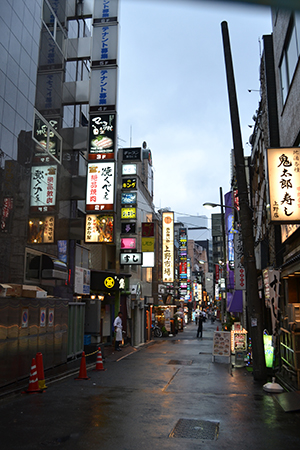
Like China today, from the Meiji Restoration on, Japan was obsessed with the West. The people and government had a drive to built newer- bigger- better and, with few exceptions, eschewed preserving its architectural legacy. Morphologically, however, Japanese urban structure has remained for the most part true to its past. Japan historically has not prioritized public space as the calling card for visitors to the city. More concerned with the private and the interior, Tokyo is administratively divided up by the various irregular-shaped chome. Tokyo streets are a part of these units, not an entity unto themselves. In most instances, streets do not even have names, and are, if anything, only referenced by inscrutable signposts with the names and numbers of the property and the name of the chome. In the West, the streets are paramount and are thought of as lines of unifying identity. Therefore, we label way-finding based off of street names. In Tokyo, private property and neighborhoods are most important, thus the streets are relegated to a lower status of either dividing lines between chome or anonymous divisions within the chome.
This is not to say, however, that Japanese streets (such as they are), are dead zones filled with garbage and stray animals. Quite the opposite: They are incredibly lively, with multitudes of shoppers visiting small shops and food stands. In Akasaka, the streets even evoke a Parisian passage, with an acrylic tube protecting shoppers. Retirees meander slowly past shops chatting and picking up maybe one or two items. Business people meet clients or colleagues for lunch. Younger Japanese meet friends in the evening for cheap noodles and then a round of video games at the arcade. One has the sense that anything and everything can and has happened in these streets.
In the West, public space (be it streets, plazas or squares,) exists as a rich physical setting. We give much attention to facades, and to the layout and presentation. In Japan, traditionally, the public space itself is as a physical thing is not important. What is important is the people and the activity they bring to the space. This philosophy extends to the signage prevalent on the sides of Japanese buildings. Large, protruding and messy, these signs can be looked at as the extension of the human activity. Dynamic--blinking, glowing and moving--these signs and the people engaged in public life transmit a babble of street information that all but obscures the static facades of buildings, rendering them unnoticeable.
Japanese public space has, in some instances, been heavily westernized. Take the major Tokyo shopping street Ginza. Walking down this street at night is one of the most sumptuous experiences in Tokyo. Each tall, narrow building is occupied by a brand name store and the facades of these buildings display the brand image and in some cases the wares inside. Designed by some of the most highly recognized names in architecture, these building facades are very much the center of attention on the streets. The Chanel facade, reminiscent of the ever-present signs in less auspicious Tokyo neighborhoods, dazzles with millions of LED lights creating abstract and enticing patterns, shapes and colors. The Dior facade evokes Japan's high-precision robotic legacy with crisp but feminine punched metal screens. One of the more memorable facades in Ginza belongs to Uniqlo, which has a hundred mannequins dressed in colorful outfits all rotating in tandem up its ten-story glass facade. Ginza perfectly captures the western notion of "modern" Tokyo-- pulsing with life, visually thrilling, full of sound and color, movement and light.
The downside of this Western model of street is that it is quite static. Once a gorgeous facade is built, it will be there for twenty-five, fifty, or a hundred years. Though the activity and use may change, the space is essentially fixed, a song where the same familiar melody is repeated ad infinitum. In the traditional Tokyo street, where the buildings are nondescript and hiding behind signs and people and life, the built environment offers more opportunity to experience authentic Tokyo city life. These buildings are the underlying pulse of the street, the riff repeated that gives a structure and backdrop for the sorts of innovation and inspiration and imagination and improvisation that have made Tokyo such a draw for visitor. Because when foreigners do get woozy and fatigued from the rawness of too much feeling in Tokyo, it is this riff, this sequence of repetitions that sends them over the edge.
